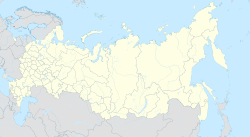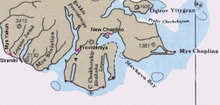world.wikisort.org - Russia
Novoye Chaplino (Russian: Новое Чаплино, Siberian Yupik: Ungaziq) is a village (selo) in Providensky District of Chukotka Autonomous Okrug, in the Far Eastern Federal District of Russia. Population: 419 (2010 Census);[2] [3] Municipally, Novoye Chaplino is subordinated to Providensky Municipal District.[5] In 2010, a law was passed abolishing the municipal rural settlement of Novoye Chaplino. The village continues to exist, but is now municipally part of Providenia Urban Settlement.[5]
Novoye Chaplino
Новое Чаплино | |
|---|---|
Selo[1] | |
 Road to Novoye Chaplino | |
Location of Novoye Chaplino  | |
 Novoye Chaplino Location of Novoye Chaplino  Novoye Chaplino Novoye Chaplino (Chukotka Autonomous Okrug) | |
| Coordinates: 64°29′54″N 172°51′42″W | |
| Country | Russia |
| Federal subject | Chukotka Autonomous Okrug[1] |
| Administrative district | Providensky District |
| Founded | 1958 |
| Population | |
| • Total | 419 |
| • Estimate (January 2016)[4] | 362 |
Municipal status | |
| • Municipal district | Providensky Municipal District[5] |
| • Urban settlement | Provideniya Urban Settlement[5] |
| Time zone | UTC+12 (MSK+9 |
| Postal code(s)[7] | 689272 |
| Dialing code(s) | +7 42735[8] |
| OKTMO ID | 77710000106 |
History
Origins
The village was founded in 1960,[9] although some sources state that it was founded in 1958[10] as a result of the merging of several nearby coastal villages into one. Villages such as Unazik (lit "Bewhiskered" in Yupik and formerly an important local whaling centre[9]), Kivak (lit. "Green Glade" in Yupik and the site of an ancient settlement several thousand years old[9]) and Plover,[10] as well as settlements from much further up the coast such as the now abandoned village of Naukan.[10]
Post-Soviet history
Novoye Chaplino is a good example of how following the collapse of the Soviet Union, the outflow of Russian migrants allowed indigenous people to take up senior administrative posts in the local administration.[11] In a similar situation to other Chukotkan villages such as Markovo,[12] During Soviet times, about 25% of the population of the village were non-indigenous in-comers.[11] Despite being in the minority, they formed the majority of senior employees in areas such as the state farm, village administration and technical services.[11] In-comers also dominated senior positions at the school including the principal, boarding-school supervisore, administrative director, bookkeeper and 11 out of the 18 licensed teachers.[11]
Following the collapse of the Soviet Union, indigenous people managed to gain more influence in their key local services. By 1995, in-comer departure was almost complete.[11] Whereas over 110 people out of a population of 460 were non-indigenous in 1986,[11] barely 30 remained nine years later, and those were mostly married to indigenous villagers.[11] Although the economic situation meant that a number of local industries had closed or had truncated staff numbers,[11] in the state farm, three-quarters of the top officials were indigenous people[11] and over two-thirds (of the admittedly smaller) school were either Chukchi or Yupik.[11]
Recent history
On September 10, 2010, a law was passed abolishing Novoye Chaplino and Sireniki at municipal level.[5] Novoye Chaplino as an entity continues to exist, but it is no longer a rural settlement on its own, but simply an inhabited locality within Provideniya urban settlement. The right of the village to local administration was removed[5] and such responsibilities were taken over by Provideniya municipal administration on January 1, 2011.[5] Provideniya municipal administration also took control of all municipal property, all municipal property rights and all local budgets on this date.[5]
Demographics
The population according to the most recent census data, prior to the abolition of the rural settlement was 419,[2] of whom 206 were male and 213 female.[3] This represents a significant increase on a 2008 estimate of about 330,[10] but is flat against a 2003 estimate of 422,[13] more than 90% of which were Chukchi or Siberian Yupik.[13]
Culture and economy

The village is populated mainly by Yupik, and whaling is the main source of employment in the area.[10]
The Chaplino hot-springs are an important local attraction.[9] There are other springs near the former village of Kivak, but these are less popular due to their isolation.[9]
Climate
Novoye Chaplino has a Tundra climate (ET)[14] because the warmest month has an average temperature between 0 °C (32 °F) and 10 °C (50 °F).
| Climate data for Novoye Chaplino | |||||||||||||
|---|---|---|---|---|---|---|---|---|---|---|---|---|---|
| Month | Jan | Feb | Mar | Apr | May | Jun | Jul | Aug | Sep | Oct | Nov | Dec | Year |
| Record high °C (°F) | 3 (37) |
7 (45) |
3 (37) |
6 (43) |
14 (57) |
22 (72) |
23.9 (75.0) |
22.2 (72.0) |
19.1 (66.4) |
8 (46) |
6.1 (43.0) |
4.4 (39.9) |
23.9 (75.0) |
| Average high °C (°F) | −11.1 (12.0) |
−12.1 (10.2) |
−9.1 (15.6) |
−5.1 (22.8) |
2.4 (36.3) |
8.1 (46.6) |
11.9 (53.4) |
11.2 (52.2) |
6.9 (44.4) |
0.4 (32.7) |
−5.6 (21.9) |
−9.6 (14.7) |
−1 (30) |
| Average low °C (°F) | −15.5 (4.1) |
−17.5 (0.5) |
−15.6 (3.9) |
−11.6 (11.1) |
−2.2 (28.0) |
2.5 (36.5) |
6.2 (43.2) |
6.1 (43.0) |
2.4 (36.3) |
−2.9 (26.8) |
−9.2 (15.4) |
−13.7 (7.3) |
−5.9 (21.4) |
| Record low °C (°F) | −39.1 (−38.4) |
−33.7 (−28.7) |
−32.3 (−26.1) |
−27.3 (−17.1) |
−17 (1) |
−4.1 (24.6) |
1.7 (35.1) |
−1 (30) |
−5.6 (21.9) |
−16.8 (1.8) |
−25.7 (−14.3) |
−30.4 (−22.7) |
−39.1 (−38.4) |
| Average rainfall mm (inches) | 48 (1.9) |
36 (1.4) |
30 (1.2) |
33 (1.3) |
30 (1.2) |
36 (1.4) |
54 (2.1) |
81 (3.2) |
81 (3.2) |
60 (2.4) |
75 (3.0) |
60 (2.4) |
624 (24.6) |
| Average snowy days | 18 | 14 | 14 | 19 | 13 | 2 | 0 | 0 | 3 | 16 | 16 | 19 | 134 |
| Source: [15] | |||||||||||||
See also
References
Notes
- Law #33-OZ, Article 9.2
- Russian Federal State Statistics Service (2011). Всероссийская перепись населения 2010 года. Том 1 [2010 All-Russian Population Census, vol. 1]. Всероссийская перепись населения 2010 года [2010 All-Russia Population Census] (in Russian). Federal State Statistics Service.
- The results of the 2010 Census are given for Novoye Chaplino Rural Settlement, then a municipal formation of Providensky Municipal District, though now abolished. According to Law #148-OZ, Novoye Chaplino was the only inhabited locality on the territory of Novoye Chaplino Rural Settlement.
- Chukotka Autonomous Okrug Territorial Branch of the Federal State Statistics Service. Численность постоянного населения Чукотского автономного округа по муниципальным образованиям на 1 января 2016 года Archived 2016-08-16 at the Wayback Machine (in Russian)
- Law #45-OZ
- "Об исчислении времени". Официальный интернет-портал правовой информации (in Russian). 3 June 2011. Retrieved 19 January 2019.
- Почта России. Информационно-вычислительный центр ОАСУ РПО. (Russian Post). Поиск объектов почтовой связи (Postal Objects Search) (in Russian)
- Ministry of Justice of the Russian Federation Archived 2012-03-24 at the Wayback Machine Providensky Municipal District (in Russian)
- Strogoff p.135
- Novoye Chaplino – Beringia Park Website Archived 2010-06-10 at the Wayback Machine
- Krupnik and Vakhtin (2002) p.14
- Chereshev, p.13
- Red Cross Chukotka – Providensky District Page (Archived)
- McKnight and Hess, pp.235–7
- "Weather Averages for Novoye Chaplino from meoweather.com". meoweather.com. Retrieved October 3, 2012.
Sources
- Chereshev, E and Shestakov, A. (2003) Anadyr River Watershed, Rapid Assessment Report, Institute of biological Problems of the North, Wild Salmon Centre.
- Дума Чукотского автономного округа. Закон №33-ОЗ от 30 июня 1998 г. «Об административно-территориальном устройстве Чукотского автономного округа», в ред. Закона №55-ОЗ от 9 июня 2012 г. «О внесении изменений в Закон Чукотского автономного округа "Об административно-территориальном устройстве Чукотского автономного округа"». Вступил в силу по истечении десяти дней со дня его официального опубликования. Опубликован: "Ведомости", №7 (28), 14 мая 1999 г. (Duma of Chukotka Autonomous Okrug. Law #33-OZ of June 30, 1998 On the Administrative-Territorial Structure of Chukotka Autonomous Okrug, as amended by the Law #55-OZ of June 9, 2012 On Amending the Law of Chukotka Autonomous Okrug "On the Administrative-Territorial Structure of Chukotka Autonomous Okrug". Effective as of after ten days from the day of the official publication.). (in Russian)
- Дума Чукотского автономного округа. Закон №45-ОЗ от 29 ноября 2004 г. «О статусе, границах и административных центрах муниципальных образований на территории Провиденского района Чукотского автономного округа», в ред. Закона №89-ОЗ от 20 октября 2010 г «О преобразовании путём объединения поселений на территории Провиденского муниципального района и внесении изменений в Закон Чукотского автономного округа "О статусе, границах и административных центрах муниципальных образований на территории Провиденского района Чукотского автономного округа"». Вступил в силу через десять дней со дня официального опубликования. Опубликован: "Ведомости", №31/1 (178/1), 10 декабря 2004 г. (Duma of Chukotka Autonomous Okrug. Law #45-OZ of November 29, 2004 On the Status, Borders, and Administrative Centers of the Municipal Formations on the Territory of Providensky District of Chukotka Autonomous Okrug, as amended by the Law #89-OZ of October 20, 2010 On the Transformation via Merger of the Settlements on the Territory of Providensky Municipal District and on Amending the Law of Chukotka Autonomous Okrug "On the Status, Borders, and Administrative Centers of the Municipal Formations on the Territory of Providensky District of Chukotka Autonomous Okrug". Effective as of the day which is ten days after the official publication date.). (in Russian)
- I. Krupnik and N. Vakhtin In the 'House of Dismay': Knowledge, Culture and Post-Soviet Politics in Chukotka, 1995-6 (2002) in People and the Land. Pathways to Reform in Post-Soviet Siberia, ed. E. Kasten
- McKnight, Tom L; Hess, Darrel (2000). "Climate Zones and Types". Physical Geography: A Landscape Appreciation. Upper Saddle River, NJ: Prentice Hall. ISBN 0-13-020263-0.
- M Strogoff, P-C Brochet, and D. Auzias Petit Futé: Chukotka (2006). "Avant-Garde" Publishing House.
External links
На других языках
[de] Nowoje Tschaplino
Nowoje Tschaplino (russisch Новое Чаплино) ist ein Dorf (selo) im Autonomen Kreis der Tschuktschen (Russland) mit 419 Einwohnern (Stand 14. Oktober 2010).[1]- [en] Novoye Chaplino
[ru] Новое Чаплино
Новое Чаплино — национальное эскимосское село в Провиденском районе Чукотского автономного округа России.Другой контент может иметь иную лицензию. Перед использованием материалов сайта WikiSort.org внимательно изучите правила лицензирования конкретных элементов наполнения сайта.
WikiSort.org - проект по пересортировке и дополнению контента Википедии